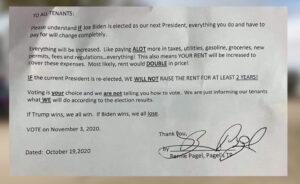November 12, 2015; Cincinnati Enquirer
Last week, the Cincinnati Enquirer featured a series of stories about the plight of 70 households ordered to leave their federally-assisted apartments when the roof of the three-story Burton Apartments collapsed. Tenants were relocated to a motel. The owner of the property reluctantly agreed to pay until Friday the 13th. Then, when city inspectors declined to certify that the building was safe for all of the returning tenants, frantic negotiations resulted in an extension of the motel stay. PF Holdings, the property owner, is no stranger to local controversy. This past July, tenants of three other PF Holdings properties filed suit because of substandard conditions.
Usually when tenants are displaced from their homes, nonprofits like Red Cross and other charities get stuck paying for displacement and relocation costs, even when owners should be held accountable to fulfill their obligation under the rental agreement. Instead of charity, tenants at Burton Apartments sought advocacy from Greater Cincinnati Coalition for the Homeless (GCCH) and Legal Aid Society of Greater Cincinnati (LASGC). These organizations have collaborated to address the needs of HUD-assisted tenants in Cincinnati on several other cases this past year. GCCH focuses on keeping tenants organized and skillfully using local media to help the tenants tell their stories, while LASGC provides legal representation,
Sign up for our free newsletters
Subscribe to NPQ's newsletters to have our top stories delivered directly to your inbox.
By signing up, you agree to our privacy policy and terms of use, and to receive messages from NPQ and our partners.
The U.S. Department of Housing and Urban Development has gotten better about helping owners and tenants deal with emergencies, so it is perplexing that HUD seems to have been caught flatfooted in this case. Earlier this year, owners of King Tower struck a deal with HUD after a disastrous fire displaced more than 20 tenants. HUD agreed to continue to pay the subsidy on the condition that the owner arranged for alternative housing while repairs were being made. This is a great policy, sort of done on the fly, using guidance developed in the wake of Hurricane Katrina. But at Burton Apartments, no such arrangements have been made, perhaps because HUD was caught off guard. Understandably, neither GCCH nor LASGC was available for comment before press time.
There seems to be a larger “troubled properties” problem at HUD. The agency keeps getting caught by surprise when troubled properties that are well known to tenants and local officials end up on the front pages of local newspapers. It appears that HUD’s system for identifying “at risk” properties has broken down and, according to some HUD officials, the agency is unsure how to fix the problem. Sources of the problem include faulty inspection protocol, a five year suspension of Management Operations Reviews (MOR), a lack of “on the ground” awareness of local conditions, a slow roll-out for a sound property disposition protocol, and a “don’t ask, don’t tell” culture among HUD staffers. Let’s look at each in turn.
- REAC scores don’t indicate real risk. In 1998, HUD created the Real Estate Assessment Center (REAC) to provide a uniform “objective” way to evaluate physical conditions in HUD assisted properties. In short order, a cottage industry of REAC consultants (see an example here) developed to counsel property owners on how to “game” the REAC system so that over time, scores increased but conditions failed to reflect these improved scores. Lately, HUD officials have begun to question whether the REAC model is capturing real risks or just noting readily observable “snapshot” conditions. One example is water stains on ceiling tiles, which, under the current system, rate a minor demerit but could be a sign of a leaking roof that warrants closer investigation. Likewise, the presence of mold is another example of a potential health problem that could be signaling water infiltration. At Burton Apartments’ most recent inspection in 2012, the property scored an impressive 90 percent (out of a possible 100). This means no reinspection for three years. There’s no indication at HUD’s online database (updated on 8/25/15) that a reinspection has been conducted. “Tweaking REAC” could be on the radar for this current HUD administration, but it seems not to be anyone’s primary assignment, and one may theorize that the REAC industry of contractors who conduct the inspections and contractors who counsel owners on how to pass the system have a vested interest in the status quo. Advocates have long argued that REAC should survey tenants before going out to a property so that inspectors can learn about physical conditions that deserve special attention.
- Hiatus in Management Operations Reviews (MOR) means no info about operations. Since 2010, HUD has failed to conduct Management Operations Reviews (MOR) on most of the Project Based Rental Assistance (PBRA) properties in its inventory because of a series of lawsuits by contractors who carry out this work. During the pendency of the litigation over how HUD was to award these lucrative contracts, the previous contactors have been working under short-term and limited scope agreements that don’t permit doing MORs. Another limitation of the MOR process is that much of the info about management performance is “self-certified” and, as with REAC inspections, there’s no provision for tenant input into the process of evaluating how management is performing. An MOR assessor can only ask the questions on the form. HUD officials guess that MORs could resume on a regular basis by 2017 when a new contract procurement system is adopted, but even then, without some reform, they may not be identifying really risky behaviors by owners and their managers.
- Local Multifamily staff have been “transformed.” This past July, the Multifamily offices in the HUD region formerly known as Region V completed its “transformation.” Many Ohio staffers were transferred to Detroit or Chicago, and many others left Ohio or the Department through voluntary transfers or retirements. A skeleton crew of HUD Multifamily staff who are left in Ohio have a kind of “caretaker” role, but it is not clear that they have a clear channel to decision makers in “the Hubs.”
- A new congressionally-mandated property disposition protocol, largely untested. Ironically, HUD has a sound approach to addressing troubled properties that fail to correct deficiencies in their physical conditions. The original protocol was written into the FY 2014 Appropriations bill and later issued as a guidance to HUD offices. When a property scores twice below 60 on its REAC scores, HUD is obliged to initiate a discussion with tenants and local stakeholders like city officials and advocates to determine how to solve the problem. Solutions could include sale of the property to responsible owners, issuing vouchers for tenants to seek housing elsewhere, or transferring the project-based assistance to another property. Burton Apartments is not eligible for this disposition protocol because of its high REAC score in 2012, but another property in this portfolio, The Alms, has had two below-60 scores. Still, there’s no apparent effort to engage tenants and the community in the resolution of these problems. Will Alms be the next to collapse?
- “Don’t ask, don’t tell” culture means that bad news doesn’t flow upstream. Even though HUD systems have proven inadequate, people at HUD should have known about Burton Apartments and the other PF holdings properties in Cincinnati. The biggest barrier to taking action against troubled properties may be a “don’t ask, don’t tell” culture at HUD where frontline staff make excuses or slip on Band-Aids in an effort to prevent disclosure of problems on their watches. There were clear indicators in Cincinnati, including communications from local advocates, housing code violation notices, lawsuits against owners, local news stories, and history of predatory ownership, all of which apparently failed to penetrate the bureaucracy.
Thanks to Mary Clark for sharing press releases from GCCH and to members of the National Preservation Working Group for supplying background on the troubled properties issue.—Spencer Wells













